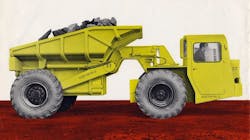The First Articulated Dump Trucks
The articulated dump truck is a common sight on most earthmoving projects today. This nimble hauling vehicle, ADT for short, is one of the newest and most successful types of earthmoving equipment to enter the field, but it was not an immediate success when introduced some 50 years ago.
The Historical Construction Equipment Association (HCEA) is a 501(c)3 nonprofit organization dedicated to preserving the history of the construction, dredging and surface mining equipment industries. With more than 4,000 members in 25 countries, activities include operation of National Construction Equipment Museum and archives in Bowling Green, Ohio; publication of a quarterly magazine, Equipment Echoes, from which this text is adapted, and hosting an annual working exhibition of restored construction equipment. Individual memberships are $30 within the U.S. and Canada, and $40 elsewhere. Information is available at www.hcea.net, 419.352.5616, or [email protected].
Early ADT pioneers did not make a fortune in sales. The industry showed little interest, and the companies were forced to discontinue their product after only a few years. Although none of these pioneers remains in business today, their legacy survives in the machines produced by the current ADT manufacturers. And thanks to later manufacturers such as Volvo, DJB and Terex, who have promoted the advantages of this type of equipment, the ADT is now regarded as an essential machine in most earthmoving spreads.
Articulated hauling units date back to the 1940s when prime movers designed for pulling scrapers were coupled to rear-dumping or bottom-dumping trailers. Following LeTourneau’s Tournarocker, leading manufacturers such as Allis-Chalmers, Caterpillar, International Harvester, Wooldridge, and Euclid offered earth-hauling trailer options for their scraper prime movers. All these units were by definition articulated haulers, but were not designed on the same lines as the modern-day ADT now enjoying worldwide popularity.
The modern ADT is a new class of earthmoving vehicle, quite different from the scraper-type prime mover that was heavily built as a scraper unit to excavate and haul material in tough conditions. The ADT is faster on the road, built to a lighter specification, cheaper to operate, and designed for a single purpose: to haul excavated material.
In the 1950s, several manufacturers began to offer earth wagons coupled to reinforced agricultural tractors such as International, Case and Fordson. Pulling a load on a trailer was found to require less horsepower and was more efficient than carrying a load on the prime mover itself. During the 1960s, these haulers evolved into the single-purpose, unitized articulated dump truck we know today.
The first two-axle articulated hauler designed as an integral unit was built in 1957 by Northfield Industrial Fabrications Ltd. of Ossett, Yorkshire, England, as a prototype unit, and introduced in 1960 as the Northfield F7 following an extensive testing program. This forerunner of the modern-day ADT could carry 12 tons and boasted most features found in today’s ADT, including 180-degree articulation actuated by two pairs of hydraulic cylinders. Power came from a Ford 6D 96-horsepower diesel engine.
One look at the accompanying picture of the Northfield will reveal it was ahead of its time. Apart from its modern-looking appearance, it also featured a torque converter, epicyclic gear box, two-pedal control and a top speed of 28 mph. Its powerful double-acting hydraulic hoist rams could dump a load in seven seconds. Northfield replaced the F7 with the beefed-up 14-ton F9 about 1964, and followed up with the F12, a 20-ton machine powered by a Perkins 6/354 diesel of 120 horsepower.
